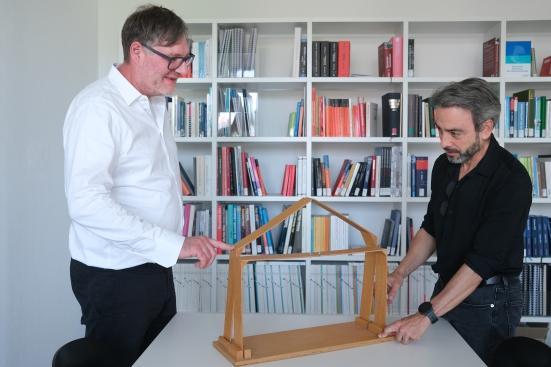Combining aesthetics and statics
The pillar in the room disturbs him. Every time Prof. Dr. David Gallardo Llopis enters the office of his colleague Prof. Dr.-Ing. Thorsten Weimar, his gaze lingers on it. "It shouldn't really be there," says the architect and structural engineering specialist from Spain, who is spending a year at the University of Siegen as a visiting researcher. At the time, architects and engineers didn't talk to each other enough or didn't understand each other. And that - the architect Gallardo Llopis and the engineer Weimar agree - should not be the case. Both teach structural engineering to future architects, and both are motivated to show students in their field a path between design and construction, between aesthetics and structure.
Because whether it's a chair or a house, a bookshelf or a bridge: If something is to last, the supporting structure has to be right. Anyone studying architecture should learn this. But how and how intensively, when there are engineers whose expertise is in demand? The situation is different in Germany and Spain, as Gallardo Llopis explains. The architect has been teaching various subjects within the framework of structural engineering at the Universitat Politècnica de València for 27 years. At the University of Siegen, he is particularly interested in the aspect of how structural design is taught to architecture students here. Alongside Professor Weimar, he also discusses this topic with Dr.-Ing. Katja Wirfler, architect and research assistant at the Chair of Structural Design, whose dissertation was supervised by Professor Gallardo Llopis as the second reviewer.
One name comes up again and again in these conversations: Curt Siegel. Professor Weimar takes a book from the shelf of the chair's library entitled "Structural Forms of Modern Architecture". The slightly yellowed pages hint at its age. "It's a classic of structural design," he explains. As an architect and university lecturer, Siegel fundamentally reformed structural design teaching for architects over 65 years ago. "But his approaches are still relevant," Weimar and Gallardo Llopis agree. This is because Siegel gave students access to load-bearing structures primarily through built examples from the history of architecture. How do forces flow in building components? How do building materials work? "Over 300 pages and not a single formula," emphasizes Gallardo Llopis. For him and the researchers in Siegen, this is a decisive motivation to rethink the theory of load-bearing structures in architecture.
"Of course, architecture students need to know the physical forces and how they are transported via the load-bearing structure of a building, but they don't need to be able to calculate them in detail in order to develop a structural concept when designing," says Weimar. Gallardo Llopis agrees. "Unfortunately, that's the case here in Spain. Architecture students have to deal with load-bearing structures from the second to the last year of their studies and be able to calculate everything. But the professional reality is different. Most architects in Spain work in the same way as in the rest of Europe. They are involved in the design of the structure, but then they hire a structural engineer to carry out the calculations." For students in Spain, structural engineering in this form is therefore just a huge hurdle. "Here in Siegen, I can see how it can be done better." He is currently writing a textbook on structural engineering, which he hopes will be the starting point for a reform in Spain. "You can teach structural design in a much more visual, intuitive and efficient way," says Gallardo Llopis. "Curt Siegel already recognized that back then."
Today, digital tools are available for this. "Based on Siegel's approaches, we want to develop innovative applications in Siegen so that students can gain a digital understanding of the different load-bearing structures," explains Weimar. The research project is called "Programmed Structural Design 2.0", which Wirfler is developing together with her colleague Dr. Andreas Hoffmann from the Chair of Operating Systems and Distributed Systems. In interactive exercises, architecture students can simulate the visualization of forces and deformations in load-bearing structures in real time. "This specifically trains the intuitive understanding of the relationship between construction and form," explains Weimar. Gallardo Llopis is not only another expert, but also an outstanding programmer. In return, he would like to take the ideas back to Valencia at the end of his one-year stay.
Professor Gallardo Llopis: "I would like to remain in close contact with the Chair of Structural Design in the future and take part in the revision of structural design, because I am convinced that the results will be very valuable not only for the University of Siegen, but also for my current teaching approach at the Universitat Politècnica de València."


